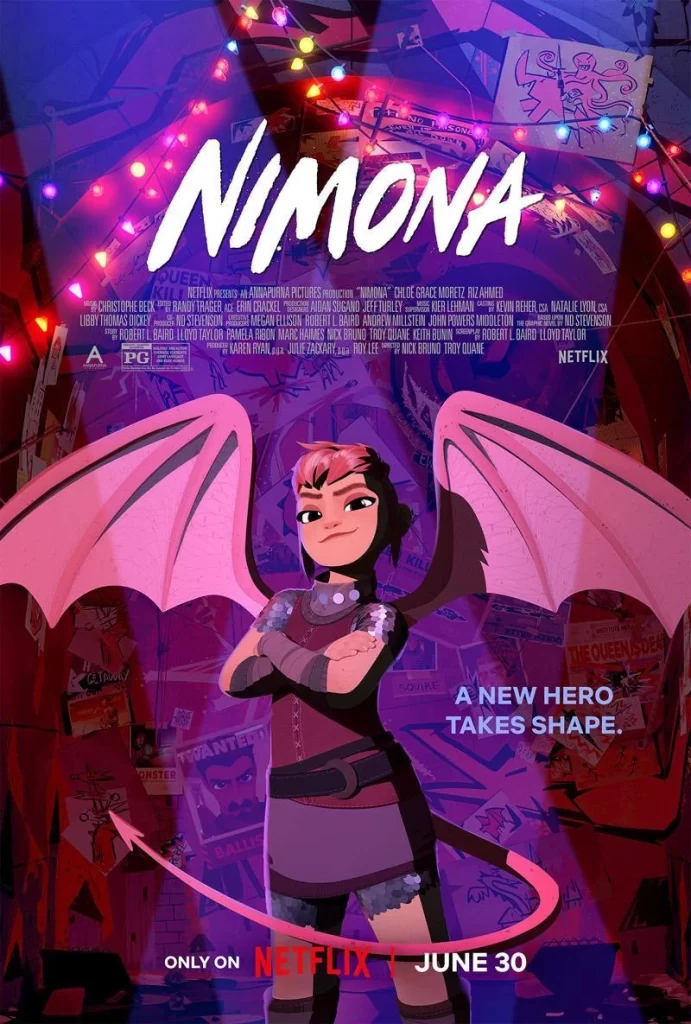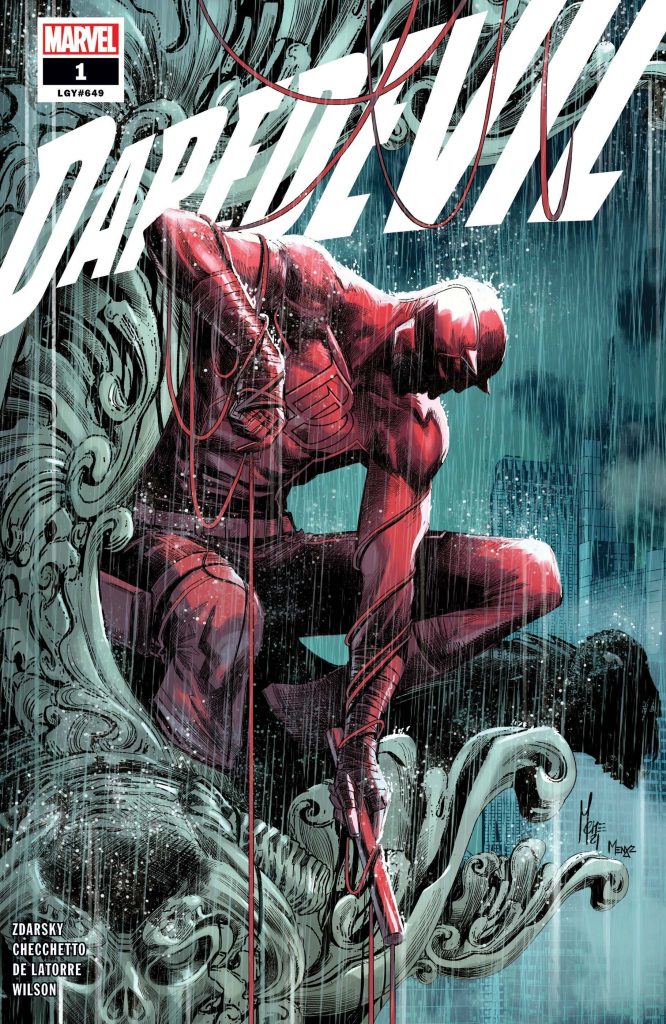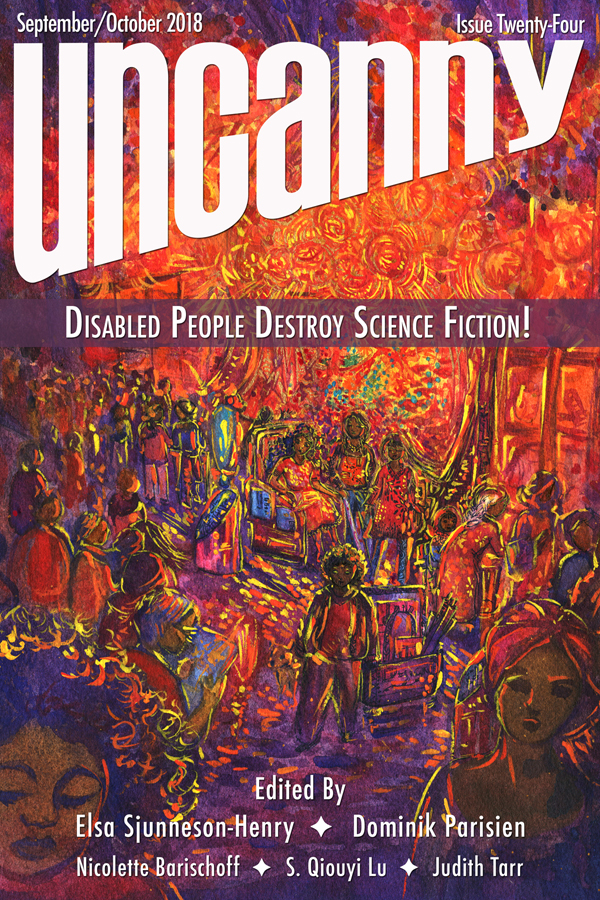Nimona
Par Magdalena Nitchi

Après avoir passé plusieurs années coincé en production, le film Nimona est enfin arrivé sur Netflix. Basé sur le roman graphique homonyme de N. D. Stevenson, Nimona offre une nouvelle vision de cette histoire fascinante: un chevalier méchant est rejoint dans sa quête d’abattre une institution de chevaliers corrompus par une adolescente métamorphe. Nimona a deux objectifs: semer le plus de chaos possible et rendre les plans de Sir Ballister Blackheart vraiment diaboliques.
Dans le roman graphique, la nature méchante de Ballister est liée à son handicap: l’Institution qui contrôle les chevaliers du royaume lui a tourné le dos après qu’il ait perdu un de ses bras au combat. Par contre, dans le film, Ballister se fait piégé et perd son bras dans un incident qui mène à des accusations de meurtre à son encontre. Bien que son handicap fasse toujours partie de l’histoire, après que Ballister se construit un nouveau bras, son attention se tourne vers sa quête pour prouver son innocence plutôt que vers la gestion de sa perte, comme dans le roman graphique. Cependant, il existe plusieurs façons de réagir à un traumatisme, et la complexité de ce processus est quand même reflétée dans le développement de Ballister.
Nonobstant, la vraie star de ce film reste Nimona. Elle est brillante, exubérante, et incarne l’énergie d’un personnage « chaotique neutre » de D&D. Son design est vraiment bien représenté à l’écran et l’équipe d’animation a fait un excellent travail sur ses métamorphoses. Le changement de forme de Nimona est bien évidemment une allégorie trans, développée par la correction constante des personnes qui l’appellent une « fille », sans parler du malaise qu’elle ressent lorsqu’elle essaie de maintenir sa forme socialement acceptable. La façon dont elle lutte pour s’intégrer mais se retrouve constamment traitée de « monstre » nous permet non seulement de sympathiser avec elle, mais aussi de mieux comprendre pourquoi elle préfère embrasser son rôle d’antagoniste.
En fin de compte, Nimona est l’histoire poignante de deux parias qui se rencontrent et forment une famille en luttant contre un régime oppressif. C’est un film d’animation époustouflant, parfait pour toute la famille, qui a largement valu son temps d’attente.
Chip Zdarsky’s Daredevil
By Frederico Azeredo

Between his current run on Batman and his Image series Newburn, it’s a wonder Chip Zdarsky has had the time to continually reinvent the Man Without Fear since 2019. Yet his latest arc, “The Red Fist Saga,” now in its thirteenth (!) issue, keeps making all the right choices and delivering consistent twists that remain true to the central character. What’s more, like his great predecessors Brian Michael Bendis and Frank Miller, Zdarsky isn’t interested in just maintaining a status quo—he wants to shake things up as much as he can without blowing the series’ very foundations.
It would be easy to decry the run as an ‘actionization’ of the usually crime and mystery-oriented Daredevil title, as it sees the increased presence of supervillains like Typhoid Mary and features showdowns so massive they annihilate chunks of New York City. Yet, these elements almost always emerge from established continuity and are grounded by a relentless focus on Matt Murdock’s personal life. His blindness, especially, is given renewed emphasis—which is refreshing, considering his preternatural ‘sonar sense’ leads many writers to forget it entirely.
For instance, after a hookup early in the story, he asks his date, “please don’t make my disability your fetish.” It’s a little in your face, but a nice touch to remind readers of the challenges Matt would still face in 2019. Later on, his adulterous relationship with Mindy Libris, who turns out to have married into the Libris crime family, helps throw shades of grey into the usual cops vs. mobsters dynamic—even archvillain Wilson Fisk gets some emotional subplots.
Those complex human stakes are what make the big twists–most shocking of all, longtime love interest Elektra taking on the Daredevil mantle while Matt wallows in prison–ring true. It’s rich, engrossing stuff for Daredevil diehards and newbies alike, though I recommend anyone starting out go back to the first issue of this run rather than just pick up the latest book. Trust me, it’s worth it.
Disabled People Destroy Science Fiction
By Magdalena Nitchi

“Disabled People Destroy Science Fiction,” the 24th issue of Uncanny Magazine, features fiction, poetry, interviews, and personal essays from disabled science-fiction authors. Published in 2018 and the winner of an Aurora award in 2019, this is the perfect read for Disability Pride Month. In spite of the title, I find that the issue is really more about building than tearing down; rather than taking apart sci-fi as a genre, the featured authors simply wish to create a space for themselves within it.
In a genre where advancements in science are often used as a way to cure or erase disabilities—such as advanced technology allowing for the regrowth of limbs rather than the use of prosthetics—it can be difficult to find science fiction that features disabled characters in a positive way. For me, the best way to get a sense of the ever-growing diversity present in SF is always to pick up an anthology. In this issue, Uncanny Magazine has put together an incredible collection that captures the daily life and clever adaptations of those who are mentally and physically disabled.
Of all the offerings in this issue, Alexander Williams’ “The House on the Moon” is my favourite. Williams’ short story follows a disabled 8th-grader, originally from Earth, who has come to settle on the moon. As she explores an odd castle constructed by a rich man with the rest of her class, she uncovers the secret that led to his demise, and learns more about a eugenics war that tore earth apart.
While many people might be more drawn to the fiction, I enjoyed reading the personal essays most. Covering topics from Afrofuturism to Avengers: Infinity War, as well as more general genre critiques, there is truly something for everyone here. Marissa Lingen’s “Malfunctioning Space Stations,” about her experience with a balance disorder, is a particularly interesting read which gave me insight into something totally new, and excellently uses the metaphor of the space station. These essays not only capture how disabled people experience community, but also their varied (and conflicting) access needs.
Uncanny Magazine continues to be the perfect venue for all kinds of talented writers to shine, and I enjoyed taking my time and reading through the full collection. If you are interested in checking out the issue, “Disabled People Destroy Science Fiction” is available for free through their website.
